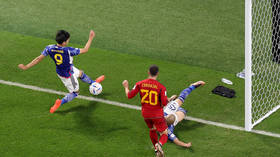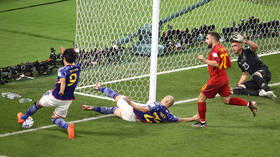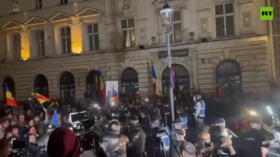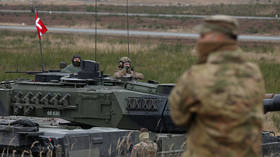FIFA explains controversial Japanese World Cup goal (VIDEO)

FIFA has said that the “evidence available” proves that Japan’s controversial winning goal against Spain in Thursday’s World Cup action should have stood.
Ao Tanaka’s second-half goal initially appeared to have crossed the dead ball line before it was directed into the six-yard box by Kaoru Mitoma for Tanaka to prod home from close range, but the goal was allowed to stand after prolonged consultation with VAR.
Subsequent television replays appeared inconclusive, with some seeming to suggest that the ball had remained within the field of play and others looking to show that it had not.
The laws of football state that the entire sphere of the ball must be over the line for it to be considered out of play.
The goal proved to be a crucial one. It ultimately leapfrogged Japan into top spot in Group E with Spain finishing as runners-up, while Germany were eliminated in the group stages for the second World Cup in succession.
So tight was the margin that one prominent UK analyst demanded that FIFA provide the evidence with which the VAR officials made the call - and on Friday world football’s governing body published two posts to its official Twitter account in a bid to explain the decision-making process.
Japan’s second goal in their 2-1 win over Spain was checked by VAR to determine if the ball had gone out of play. The video match officials used the goal line camera images to check if the ball was still partially on the line or not. pic.twitter.com/RhN8meei6Q
— FIFA.com (@FIFAcom) December 2, 2022
Other cameras may offer misleading images but on the evidence available, the whole of the ball was not out of play. pic.twitter.com/HKKEot0j1Y
— FIFA.com (@FIFAcom) December 2, 2022
“Japan’s second goal in their 2-1 win over Spain was checked by VAR to determine if the ball had gone out of play,” FIFA wrote.
“The video match officials used the goal line camera images to check if the ball was still partially on the line or not.”
FIFA added in a second tweet: “Other cameras may offer misleading images but on the evidence available, the whole of the ball was not out of play.”
In the second post FIFA made the case that the ball could have appeared in or out of play depending on the perspective from which it was viewed, with its recreation showing that a part of the ball was hanging over the line.
“If it was really out it would have been a goal kick, but the judgement of the referee was it was in,” Japan coach Hajime Moriyasu said afterwards.
“We respected it, but we were willing to respect either way. The final judgement was it was in.”
Spain boss Luis Enrique wasn't quite so philosophical: “I felt that something fishy was going on when the VAR took as much time as it did to decide… I have nothing to say.”














